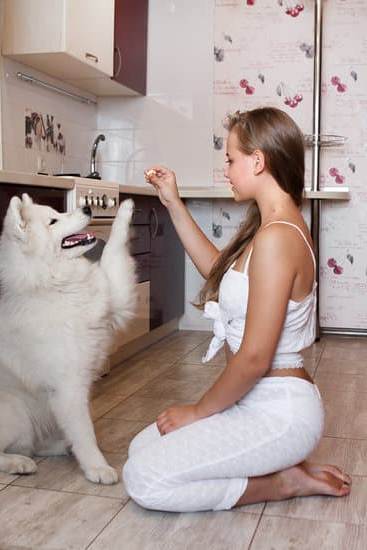Training your dog to use a bell to go outside is a valuable skill that can greatly improve communication between you and your furry companion. Not only does it provide a clear signal for when your pup needs to go out, but it also helps prevent accidents indoors. This article will guide you through the process of teaching your dog this useful behavior, from selecting the right bell to troubleshooting common issues that may arise during training.
By incorporating a bell into your dog’s routine, you can give them a simple yet effective way to communicate their needs. Whether you have a puppy who is still learning the ropes or an older dog who needs a refresher, using a bell can be a game-changer in potty training efforts.
The sound of the bell serves as a cue for your pet to alert you when they need to go outside, fostering good habits and promoting better bladder control.
In this comprehensive guide, we will explore the various aspects of training your dog to use a bell, including choosing the right type of bell and setting it up in your home strategically. With step-by-step instructions on how to teach your dog to ring the bell and rewarding them for doing so correctly, you’ll be well on your way to establishing a reliable communication system with your four-legged friend.
So let’s dive in and unlock the benefits of mastering this crucial skill together.
Choosing the Right Bell
When it comes to training your dog to use a bell to go outside, one of the key factors to consider is choosing the right bell. There are various types of bells available on the market, each with its own set of features and benefits.
One popular option is the classic sleigh bell, which produces a clear and distinct sound that is easy for your dog to recognize. Another choice is a jingle bell, which has a softer tone but can still be effective in getting your dog’s attention.
In addition to the type of bell, you’ll also need to consider the material it is made from. Bells come in different materials such as brass, stainless steel, or even plastic. Brass bells are durable and have a traditional look, while stainless steel bells are rust-resistant and easy to clean. Plastic bells may be lightweight and affordable, but they may not be as long-lasting as metal options.
When selecting a bell for your dog, it’s essential to choose one that is sturdy and able to withstand daily use. Consider your dog’s size and behavior when choosing the right bell – smaller dogs may require a lighter bell, while larger breeds might need something more robust. Ultimately, the goal is to pick a bell that will be comfortable for your dog to nudge or ring when they need to go outside.
| Bell Type | Material |
|---|---|
| Sleigh Bell | Brass |
| Jingle Bell | Various materials including stainless steel or plastic |
Setting Up the Bell
Training your dog to use a bell to go outside can be a game-changer for both you and your furry companion. It provides a clear communication method for your dog to signal when they need to relieve themselves, reducing accidents in the house. Setting up the bell in the right location is crucial for ensuring its effectiveness and making the training process smoother.
To maximize the effectiveness of the bell, consider the following placement tips:
- Choose a location near the door: The bell should be placed close to the door that your dog typically uses to go outside. This will help your dog associate ringing the bell with going out.
- Place it at nose level: Hang the bell at a height where your dog can easily reach it with their nose or paw. This makes it more convenient for them to interact with the bell.
- Avoid noisy areas: While you want the bell to be easily accessible, make sure it’s not in a high-traffic area where loud noises or distractions could interfere with your dog using it effectively.
By strategically placing the bell in a location that is accessible and associated with going outside, you set up your dog for success in learning how to use it correctly.
Remember that consistency is key during this training process. Be patient with your pup as they learn this new skill and always praise and reward them when they successfully ring the bell before going out.
The Training Process
Introducing the Bell
Start by introducing the bell to your dog in a calm environment. Let them sniff and investigate the bell to become familiar with it. You can even add some treats or peanut butter on the bell to make it more enticing for your dog. Once they are comfortable with the presence of the bell, move on to the next step.
Association Training
Associate ringing the bell with going outside. Every time you take your dog out, ring the bell before opening the door. Over time, your dog will start to associate ringing the bell with going outside to potty. Be consistent with this routine so that your dog can make a clear connection between ringing the bell and going out.
Reinforcement and Practice
When your dog rings the bell on their own or even accidentally, immediately reward them with praise, treats, or playtime outside. This positive reinforcement will encourage them to continue using the bell. Practice this routine multiple times throughout the day until your dog starts using the bell consistently when they need to go outside. Remember, patience is key in this training process.
By following these steps and being consistent in your training efforts, you will successfully teach your dog how to use a bell to signal when they need to go outside. Just remember to stay patient, provide positive reinforcement, and soon enough, your furry friend will be ringing that bell like a pro.
Troubleshooting
Training your dog to use a bell to go outside can be a game-changer for both you and your furry friend. However, like any training process, there may be some common issues that arise along the way. It’s essential to troubleshoot these problems promptly to ensure that your dog learns how to use the bell effectively. Here are some common issues and how you can address them during the training process:
1. Ignoring the Bell: Some dogs may initially ignore the bell or not understand its purpose. If this happens, try using treats or their favorite toy to associate ringing the bell with a positive reward. Encourage your dog to touch or nudge the bell using their nose or paw to create this association.
2. Fear of the Bell: In some cases, dogs may be afraid of the sound or presence of the bell. To address this issue, introduce the bell gradually by placing it away from your dog at first and slowly moving it closer over time. Use positive reinforcement and praise when your dog shows curiosity towards the bell without fear.
3. Accidental Ringing: Your dog may accidentally ring the bell while playing or roaming around the house, which can lead to confusion. To tackle this issue, guide your dog back to the designated potty area when they ring the bell unintentionally, but do not take them outside every time unless they genuinely need to go potty.
By addressing these common issues during the training process, you can help your dog successfully learn how to use a bell to go outside without any hiccups along the way. Remember to be patient and consistent in your training approach for best results.
Reinforcement
Benefits of Positive Reinforcement
Using positive reinforcement is a key element in training your dog to use a bell to go outside. Dogs respond well to rewards such as treats, praise, or playtime when they exhibit a desired behavior, in this case, ringing the bell to signal their need to go outside.
By rewarding your dog consistently every time they ring the bell, you are reinforcing the connection between the action and the reward, making it more likely that they will continue to use the bell in the future.
Types of Rewards
When rewarding your dog for using the bell correctly, it is important to choose rewards that are highly motivating for them. This could be their favorite treat, a special toy, or even some extra attention and affection from you.
Make sure to have these rewards readily available each time your dog rings the bell so you can immediately reinforce their behavior. Consistency is key in training, so make sure to use the same reward each time they ring the bell to avoid confusion.
Maintaining Consistency
Consistency is crucial in reinforcing your dog’s behavior when using the bell. Make sure that everyone in your household follows the same reward system so that your dog does not get mixed signals. Additionally, be patient and give your dog time to learn and adjust to using the bell.
Remember that every dog is different and may take varying amounts of time to fully grasp this new concept. With patience, consistency, and positive reinforcement, your furry friend will soon become a pro at signaling when they need to go outside by ringing their special bell.
Gradual Transition
Once your dog has mastered the task of using a bell to signal when they need to go outside, it’s important to gradually phase out the use of the bell. This transition is crucial for reinforcing their independence and self-reliance when it comes to communicating their needs.
By following a few simple steps, you can smoothly transition your dog away from relying on the bell while still ensuring they have a way to let you know when they need to go out.
To begin phasing out the bell, start by introducing verbal cues or commands that your dog can associate with going outside. For example, you can say phrases like “outside” or “potty time” when you take them out. By consistently using these verbal cues in conjunction with the bell, your dog will start to understand that they can communicate their needs through both methods.
As your dog becomes more familiar with the verbal cues, gradually decrease the reliance on the bell by occasionally ignoring it when they ring it. Instead, pay attention to their behavior and body language – if you notice signs that they need to go out, respond to those cues instead of waiting for the bell.
This helps reinforce the idea that communication is not solely dependent on ringing the bell and encourages your dog to use other ways to signal their needs.
Additional Tips and Tricks
Training your dog to use a bell to go outside can be a game-changer for both you and your furry friend. Not only does it provide a clear communication method for your pet to let you know when they need to go potty, but it also helps in preventing accidents indoors. To make the training process smoother and more effective, here are some expert tips and tricks that you can follow.
First and foremost, consistency is key when training your dog to use the bell. Make sure to establish a routine and stick to it. Take your dog out at regular intervals throughout the day, such as after meals, naps, and playtime. This will help them associate the bell with going outside to relieve themselves. Additionally, be patient during the training process – every dog learns at their own pace, so stay positive and persistent.
Another tip is to make the bell sound enticing for your dog. You can do this by associating the ringing of the bell with something positive, like treats or playtime. Encourage your dog to paw at or nose the bell whenever they need to go outside, and reward them immediately after they ring it successfully. This positive reinforcement will help reinforce the behavior of using the bell effectively.
Lastly, don’t forget to praise your dog lavishly whenever they use the bell correctly. Use verbal cues like “good job” or “well done” in a happy tone of voice to let them know they did well.
Your encouragement will motivate them to continue using the bell consistently. Remember that every interaction with your pet is an opportunity for bonding and building trust between you both while teaching them this valuable skill on how train dog use bell to go out.
Conclusion
Teaching your dog to use a bell to go outside may initially seem like a daunting task, but the benefits far outweigh any challenges you may encounter during the training process. Not only does it provide your furry companion with a clear communication method for when they need to go out, but it also creates a sense of independence and empowerment for them.
By following the step-by-step guide outlined in this article, you can successfully train your dog to use the bell in no time.
One of the key aspects of this training is consistency. Consistently reinforcing the bell as the signal for going outside will help your dog understand its purpose and use it effectively. Remember to be patient and positive throughout the training process, as dogs respond best to encouragement and rewards. By using treats or verbal praise as reinforcement, you are not only teaching your dog a valuable skill but also strengthening your bond with them.
As you progress through the training and your dog becomes more proficient at using the bell, you will notice a significant improvement in communication between you and your furry friend. With patience, perseverance, and dedication, teaching your dog how to use a bell to go outside can be a rewarding experience for both of you. So start today and enjoy the benefits of this simple yet effective communication tool.
Frequently Asked Questions
How Do You Train a Dog to Pee Outside With a Bell?
Training a dog to pee outside with a bell involves associating the sound of the bell with going outside to potty. Start by teaching your dog to ring the bell every time before going out. Then, take them outside immediately after they ring the bell and give praise when they pee outside.
How Do You Train a Dog to Use a Doorbell Outside?
To train a dog to use a doorbell outside, you can follow similar steps as training them to use a bell for potty breaks. Introduce the doorbell as a signal for wanting to go outside and reinforce this behavior by letting them out whenever they ring it. Consistency is key in this training process.
How Do I Train My Dog to Alert Me to Go Outside?
Teaching your dog to alert you when they need to go outside can be done through various methods such as pawing at the door, barking, or using bells or buttons specifically designed for this purpose. Encourage and reward any behavior that signals their need to go out, reinforcing their communication with positive reinforcement techniques.

Welcome to the blog! I am a professional dog trainer and have been working with dogs for many years. In this blog, I will be discussing various topics related to dog training, including tips, tricks, and advice. I hope you find this information helpful and informative. Thanks for reading!





